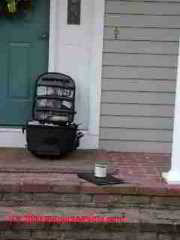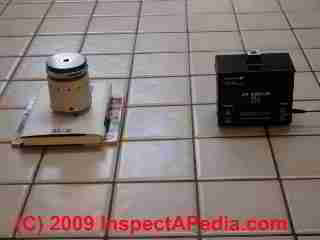 How to Compare Indoor to Outdoor Mold Counts
How to Compare Indoor to Outdoor Mold Counts
- POST a QUESTION or COMMENT about comparing outdoor mold counts to indoor mold counts - apples vs oranges?
How should we Compare Outdoor and Indoor Mold Levels or Counts - what are the sources of error?
This document is a brief tutorial which provides information about the accuracy of and sources of errors in tests for the level of allergenic and toxic mold in residential buildings:
Are spore counts valid? These critical questions are discussed in this paper.
InspectAPedia tolerates no conflicts of interest. We have no relationship with advertisers, products, or services discussed at this website.
- Daniel Friedman, Publisher/Editor/Author - See WHO ARE WE?
How to Compare Indoor Airborne Mold or Particle Counts vs. Outdoor Counts
 The University of Minnesota fungal experts observe that an outdoor-baseline comparison to indoor air is not valid
when the outdoor sample was taken during or immediately after precipitation (spore counts plummet outdoors in the rain and might soar right after it), and
the comparison is probably not valid in winter when outdoor counts tend to be below indoors.
The University of Minnesota fungal experts observe that an outdoor-baseline comparison to indoor air is not valid
when the outdoor sample was taken during or immediately after precipitation (spore counts plummet outdoors in the rain and might soar right after it), and
the comparison is probably not valid in winter when outdoor counts tend to be below indoors.
We agree and add other constraints: snow cover practically eliminates spores from outdoor air.
Even in warm weather spore counts vary during the day as weather conditions (humidity, temperature, period after rainfall) affect sporulation and spore movement.
Section 2.4.2.2 of The ACGIH Bioaerosols: Assessment and Remediation offers:
Investigators should bear in mind that samples provide information about a site as it existed at the time tested. However, the findings may not represent conditions at a time in the past or future, even the relatively recent past or near future.
Changes in the kinds, concentrations, and proportions of biological agents in the air can be rapid and substantial. -- thanks to S. Flappan for suggesting this citation.
OPINION: There are severe problems in the standard practice comparing indoor and outdoor spore counts to decide if a building has a mold problem.
1. Overall Outdoor Mold Spore Counts:
Some mold testing laboratory reports give simply an "overall outdoor spore count" number which is compared with either a specific (genera/species) or an "overall" indoor spore count number of mold spores/M3 of air.
This is a silly comparison since that data fails to identify the spore genera/species, thus masking any intelligence about the actual indoor spore risk.
For example the outdoor spores at the time of measurement may be dominated by Cladosporium sp. or Basidiomycetes while the indoor spore level at the same number of spores/M3 may be Aspergillus versicolor - which could well indicate a problem but which would not be indicated as a problem by the lab approach I've described.
You might as well say we found 100 oranges outdoors and 100 apples indoors. What the heck does that mean?
2. Outdoor Pen/Asp may be Different Species than Indoor:
Even when outdoor spores are identified to the genera such as Aspergillus sp. few laboratories take the extra step to speciate
indoor and outdoor airborne spore trap sample contents. In fact speciation of many species of airborne spores in a spore trap can be
difficult or impossible by conventional means.
So an outdoor "Penicillium/Aspergillus" spore count of 3600 spores/M3 of
air may be compared with an indoor "Penicillium/Aspergillus" airborne spore level of 3500 spores/M3 of air and reach the completely
mistaken conclusion that there is no evidence of an indoor air quality problem.
Looking closely at the indoor spores might, however, have disclosed that the indoor "Penicillium/Aspergillus" was a completely different mold species than the outdoor species - making the indoor-outdoor comparison a meaningless "apples and oranges" comparison.
Yet that comparison is the common one made by many field investigators.
Worse, certain basidiomycetes are difficult to recognize in air samples and are counted by some laboratories as "Pen/Asp" when in fact they may not even be in those genera.
Air samples may miss important particles or may point to the "wrong" particles
High risk of false negative airborne mold test results:
Indoor air samples are at high risk of giving a "false negative result" - indicating no problem when a problem is present, either completely missing the presence of the most problematic spores in a building or which indicating as "the problem" the wrong spores in a building simply because they were dominant at the time sampled.
Outdoor or indoor "Pen/Asp" spore counts are often compared erroneously in cases where the indoor genera/species is quite different from the indoor genera/species.
For example a "low" indoor count that is all Aspergillus niger may indicate a problem, even though it's lower than the outside "Pen/Asp" count if the outdoor count was actually Penicillium sp. or perhaps even basidiomycetes mistaken for Pen/Asp.
See complete details
at ACCURACY OF AIR TESTS for MOLD
Question: why would air-o-cell lab results show numbers for the interior, but show zero count for the exterior
(Mar 5, 2014) Jane said:
On a single family home, why would air-o-cell lab results show numbers for the interior, but show zero count for the exterior for the following spores.. aureobasidium, pithomyces, pestalotia, tetraploa and spegazzinia?
Reply:
Jane,
First, it is entirely possible that particular species of mold may grow and flourish indoors at a time when outdoors the airborne concentrations of those same species are so low as to be not detected in a brief air sample, even though as Dr. John Haines says, "all mold is everywhere all the time".
Second, some of the indoor mold genera you name may be at such a low concentration that we really would not worry about them. A few Tetraploa spores that happened to find their way indoors and get stuck there don't present a health risk nor do they indicate a flooded, mold-damaged building.
A "mold test" that only produces some "counts" and does not inspect the building is not very diagnostic.
In fact even when (some) mold reports give outdoor levels and indoor levels of what looks like the very same mold genera/species, such as Penicillium sp., the truth is that the outdoor and indoor individual species of Penicillium could be completely different, making the comparison rather misleading.
Also see AIRBORNE MOLD SPORES CONCENTRATION BURSTS that can produce the opposite: a high level of outdoor spores just during a specific interval (such as right after a rain).
In sum, we don't ever expect to find the same mold levels indoors and outdoors but they may be close if the building's windows have been opened for some time, a good breeze is blowing, and if there is no indoor mold reservoir that changes what we are seeing inside.
ACCURACY OF AIR TESTS for MOLD explains why there is plenty of variability - orders of magnitude - in any air test.
While there are about 1.5 million different mold genera/species, and while we like to say that "all molds are everywhere all the time" - which is true in a sense - one must also point out that not all molds are at the same *concentration level* all the time at a given location.
So there is no reason to expect indoor mold counts to ever exactly match outdoor counts and vice versa.
A more useful question is "what does my mold test report mean?"
Without some interpretation by an expert who has investigated the building and who understands building science, moisture movement, the building leak history, occupant complaints, and the exact protocols under which an air test or other mold test was conducted, and especially considering that you don't give any actual spore level or count data, the answer is, the information doesn't mean a darn thing. It is close to useless.
Question:
(Apr 22, 2015) Joe said:
My lab results reflect the following:
Penicillium/Aspergillus inside aire sample near return as. raw ct. 16 & per m3 850.
While the outside air @ front door to be Raw ct. 7 & per m3 370.
Would I be correct in determining the mold count was not very high to begin with?
Reply:
Yes, Joe but of course we cannot conclude much about the actual mold risk in the building from an air test alone.
See MOLD TEST vs MOLD INSPECT and
also MOLD TEST vs. PROBLEM DIAGNOSIS
...
Continue reading at ACCURACY OF AIR TESTS for MOLD - topic home, or select a topic from the closely-related articles below, or see the complete ARTICLE INDEX.
Or see these
Recommended Articles
- ACCURACY vs PRECISION of MEASUREMENTS
- ACCURACY OF AIR TESTS for MOLD - home
- AIRBORNE MOLD SPORES CONCENTRATION BURSTS
- AIRBORNE MOLD COUNTS INDOOR vs OUTDOOR
- ACCURACY of MOLD TESTS - all types of mold tests
- AIRBORNE PARTICLE TEST SAMPLING CASSETTE STUDY
- AIRBORNE MOLD SPORE COUNT GUIDE - home
- AIRBORNE PARTICLE LEVELS vs IAQ - home
- AIRBORNE MOLD COUNT VALIDITY
- AIRBORNE PARTICLE ANALYSIS METHODS
- AIRBORNE PARTICLE COUNT VARIATION CAUSES
- AIRBORNE PARTICLE COUNT VARIATION EXTENT
- FALSE NEGATIVE MOLD TEST RESULTS
- MOLD CULTURE TEST KIT VALIDITY
- MOLD TEST PROCEDURES
- MOLD TESTING METHOD VALIDITY
- MOLD TESTING & SAMPLING MISTAKES
Suggested citation for this web page
COUNT VARIATION - INDOOR vs OUTDOOR SPORES at InspectApedia.com - online encyclopedia of building & environmental inspection, testing, diagnosis, repair, & problem prevention advice.
Or see this
INDEX to RELATED ARTICLES: ARTICLE INDEX to MOLD CONTAMINATION & REMEDIATION
Or use the SEARCH BOX found below to Ask a Question or Search InspectApedia
Ask a Question or Search InspectApedia
Try the search box just below, or if you prefer, post a question or comment in the Comments box below and we will respond promptly.
Search the InspectApedia website
Note: appearance of your Comment below may be delayed: if your comment contains an image, photograph, web link, or text that looks to the software as if it might be a web link, your posting will appear after it has been approved by a moderator. Apologies for the delay.
Only one image can be added per comment but you can post as many comments, and therefore images, as you like.
You will not receive a notification when a response to your question has been posted.
Please bookmark this page to make it easy for you to check back for our response.
IF above you see "Comment Form is loading comments..." then COMMENT BOX - countable.ca / bawkbox.com IS NOT WORKING.
In any case you are welcome to send an email directly to us at InspectApedia.com at editor@inspectApedia.com
We'll reply to you directly. Please help us help you by noting, in your email, the URL of the InspectApedia page where you wanted to comment.
Citations & References
In addition to any citations in the article above, a full list is available on request.
- In addition to citations & references found in this article, see the research citations given at the end of the related articles found at our suggested
CONTINUE READING or RECOMMENDED ARTICLES.
- Carson, Dunlop & Associates Ltd., 120 Carlton Street Suite 407, Toronto ON M5A 4K2. Tel: (416) 964-9415 1-800-268-7070 Email: info@carsondunlop.com. Alan Carson is a past president of ASHI, the American Society of Home Inspectors.
Thanks to Alan Carson and Bob Dunlop, for permission for InspectAPedia to use text excerpts from The HOME REFERENCE BOOK - the Encyclopedia of Homes and to use illustrations from The ILLUSTRATED HOME .
Carson Dunlop Associates provides extensive home inspection education and report writing material. In gratitude we provide links to tsome Carson Dunlop Associates products and services.

